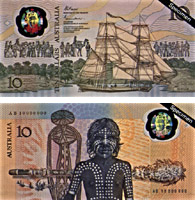
Plastic banknotes
1988
non-forgeable polymer money
The Reserve Bank of Australia, in collaboration with the CSIRO, released the world's first long lasting and counterfeit resistant polymer (plastic) banknotes in 1988 with a special Bicentennial $10 note issue.
There were problems. The ink tended to rub off ? as people who kept their money in their shoes found out the hard way! And they tended to resist folding. A new $5 note was issued without these problems, followed by new $10, $20, $50 and $100 notes. In 1996 Australia became the first country to have a full series of circulating polymer banknotes. They last ten times longer than paper notes.
Plastic notes could be illegally photocopied, but it 's virtually impossible to copy their feel, springiness and special features. The special features include clear windows and an optically variable device, an image that changes with the angle of view, which is made by a secret process invented by the CSIRO.
The polymer technology, called Guardian®, is produced by Securency Pty Ltd, a joint venture between the Reserve Bank of Australia (RBA) and UCB, a multi-national film, chemical and pharmaceutical company based in Belgium
An Australian company, Reln, recycles the worn banknotes into plastic compost bins and plumbing parts after they are shredded by the bank. Securency and Note Printing Australia, the Reserve Bank's manufacturing division, also make plastic money for a number of other countries.
Who Did It?
Key Organisations
CSIRO Division of Chemicals and Polymers : R&D
Reserve Bank of Aust (Note Printing Branch) : design, manufacture
Key People
Harry Williamson : artist, designer
David Solomon : research scientist
Further Reading
'Bank forges ahead with clean cash'
Richard Macey
The Sydney Morning Herald, 28 October 1993.
Links
Reserve Bank of Australia
Note Printing Australia
Securency
CSIRO
UCB films
Collection of polymer
banknotes
Related Innovations
EXELGRAM anti-counterfeiting technology
Passport Security
|










